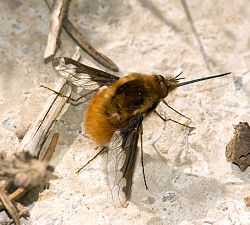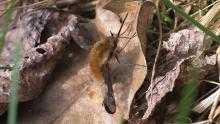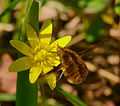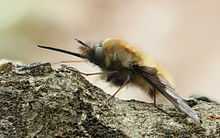Bombylius major
| Bombylius major | |
|---|---|
 | |
| Scientific classification | |
| Kingdom: | Animalia |
| Phylum: | Arthropoda |
| Class: | Insecta |
| Order: | Diptera |
| Family: | Bombyliidae |
| Genus: | Bombylius |
| Species: | B. major |
| Binomial name | |
| Bombylius major Linnaeus, 1758 | |
| Synonyms | |
| |
The Large Bee-fly, Bombylius major, is a bee mimic. The eggs are flicked by the adult female toward the entrance of the underground nests of solitary bees and wasps. After hatching, the larvae find their way into the nests to feed on the grubs.[1]
Bombylius major can be found in April to June throughout temperate Europe and North America and some parts of Asia.
Description

The adult is 14 to 18 millimetres (0.55 to 0.71 in) in length, squat and very hairy, with a wingspan of around 24 mm (0.94 in). It has dark patches on the anterior half of the wings and long hairy legs that dangle while in flight. The very long proboscis is used to feed on the nectar of many species of flower, especially primroses. While its wings continue to beat its front legs grip the flower and its long rigid beak is inserted to collect the nectar.[2] Despite its fearsome appearance, the beak is quite harmless.[2]
Bearing a mimetic resemblance to bees their body is stout and furry, with the top of the thorax being black and shiny and the pile either brown, yellow, or white. They have long spindly legs as well as a long rigid proboscis found in the front of the head. Their boldly patterned wings have a distinct dividing border through the horizontal middle between the dark and clear portions. Their antennae are typically very short and pointed. In the field they will be seen hovering and darting above bare ground or flowers, in an up-and-down movement, accompanied by a high-pitched buzz.
Reproduction
Bombylius major has several host species, including beetle larvae and the brood of solitary wasps and bees particularly digging bees such as Andrena. They mimic bees to allow them to get close to the bees burrow. When close, the female will flick the eggs into or near the nests of the host insects. The larvae are hypermetamorphic parasitoids which then feed on the food stored, as well as the young solitary bees or wasps. If the female is unable to flick her eggs near the nest she plants them on flowers visited by the host insects. The developing larvae then make their way to the host nest or attach themselves to the bees or wasps to then be carried to the nest.[3] Although Bombylius major is an excellent pollinator, the larvae limit the population of other pollinators.
-

In flight
-

On flower
-

Sunbathing
-

Resting
-
On flower Viola
See also
- List of soldierflies and allies recorded in Britain
References
| Wikimedia Commons has media related to Bombylius major. |
- ↑ Stubbs, A. and Drake, M. (2001). British Soldierflies and Their Allies: A Field Guide to the Larger British Brachycera. British Entomological & Natural History Society. pp. 512 pp. ISBN 1-899935-04-5.
- ↑ 2.0 2.1 Insects , Collins Gem , Guide, 1986, page 114, ISBN 0004588185
- ↑ Boesi, R., Polidori, C. and Andrietti, F. 2009 — Searching for the Right Target: Oviposition and Feeding Behavior in Bombylius Bee Flies (Diptera:Bombyliidae).Zool. Stud., 48:141-150.
- "Bee Fly - Bombylius major". North American Insects and Spiders. Retrieved June 1, 2010.
- "Bee Fly - Bombylius major, Species Information Page". Brickfields Country Park. December 28, 2009. Retrieved June 1, 2010.
- "BeeFly". Kendall Bioresearch. Retrieved June 1, 2010.
- Donald Joyce Borror & Dwight Moore DeLong (1964). An Introduction to the Study of Insects (2nd ed.). New York: Holt, Rinehart and Winston.
- "Species Bombylius major - Greater Bee Fly". BugGuide.Net. Retrieved June 1, 2010.
http://500px.com/photo/79888947/bombylius-by-felipe-vilarroya?from=user_library
